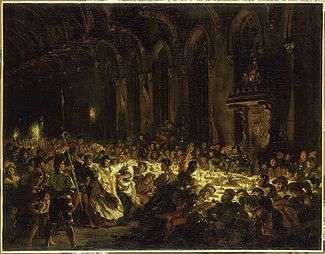Louis de Bourbon, Bishop of Liège
| Louis de Bourbon | |
|---|---|
|
Prince-Bishop of Liège (1456-1482) | |
| Born | 1438 |
| Died | 30 August 1482 (aged 44) (Assassination) |
| Cause of death | Assassinated by William de la Marck[1] |
| Occupation | Prince-Bishop of Liège |
| Years active | 1456-1482 |
| Predecessor | Jean de Heinsberg[2] |
| Children |
• Pierre de Bourbon, Bâtard de Liège • Louis de Bourbon, Bâtard de Liège • Jacques de Bourbon, Bâtard de Liège[3] |
| Parent(s) |
Charles I, Duke of Bourbon Agnes of Burgundy |

Louis de Bourbon (1438 – 30 August 1482 in Liège) was Prince-Bishop of Liège from 1456 until his death.
Family
He was the son of Charles I, Duke of Bourbon, and Agnes of Burgundy, sister of Philip the Good. His own sister Isabella was the second wife of Charles the Bold.
He was brought up and educated by his uncle Philip the Good, Duke of Burgundy, who let him study for ten years at the University of Leuven.[4]
It has been said that he married, in secret in 1464, Catherine, daughter of Arnold, Duke of Gelderland. Their son, Pierre de Bourbon, who may however have been instead a son of a mistress of Louis, founded the Bourbon-Busset family.[5] The three children of Louis were:
- Pierre de Bourbon, bâtard de Liège (1464 - 1529);
- Louis de Bourbon, bâtard de Liège (1465 - 1500);
- Jacques de Bourbon, bâtard de Liège (1466 - 1537).[3]
Conflict over the bishopric
Philip secured for him in 1456 the Prince-Bishopric of Liège,[6] by influencing Pope Callixtus III, and removing the 69-year-old Jean de Heinsberg.[2] Given the strategic position of Liège almost enclosed by Burgundian possessions, Louis was a poor choice because his behavior quickly led to troubles, permitting French meddling.[7]
The citizens rejected the new bishop and the Burgundian influence, which led to the Liège Wars. Louis was exiled to Maastricht.[8]
Marc de Bade was put in place by the Liégeois,[9] who fought under Raes van Heers,[10] but military force from Burgundy prevailed, in 1465. The resulting Peace of Saint-Trond[11] restored the bishop, but Liège lost its sovereignty. Another revolt in 1467 was crushed at the Battle of Brustem.
In the summer of 1468, Louis was back in his prince-bishopric, after a papal legate had intervened, but was captured at Tongeren by a raiding party from Liège, at that time again asserting independence of Charles the Bold of Burgundy.[12] An unlikely alliance of Charles with Louis XI, who in 1465 had helped the Liégeois against the bishop, saw Bishop Louis released.[13] Liège was taken,[14] and sacked on 30 October 1468.[15][16]
Later life
Louis sold Condé and Leuze to Marie de Montmorency.[17]
In 1477, Charles the Bold was killed, and his daughter and heiress Mary of Burgundy was forced to sign the Peace of Saint-Jacques, consolidating the bishop's position but returning sovereignty to Liège.[18] He was at this time amongst the advisers of Mary who wanted her to marry the future Charles VIII of France, then Dauphin of France.[19]
Louis ruled until 30 August 1482, when he was assassinated by William de la Marck,[1] an adventurer who from 1478 had been operating against the territory from the Castle of Logne.[20]
In literature
The murder of Louis is depicted in the novel Quentin Durward by Sir Walter Scott, but its historical details are far from accurate.[21]
Primary sources
There are numerous contemporary accounts.[22]
Notes
- 1 2 History of the duchy of Bouillon
- 1 2 Compagnie de la Verte Tente, Le 15ème siècle (in French), archived from the original on 5 May 2008
- 1 2 Cawley, Charles, "Bourbon", Medieval Lands database, Foundation for Medieval Genealogy, ; (French).
- ↑ Richard Vaughan (1970), Philip the Good, p. 123.
- ↑ These claims may date only from the seventeenth century; see Cawley, Charles, "BOURBON", Medieval Lands database, Foundation for Medieval Genealogy, .
- ↑ Vaughan, p. 223.
- ↑ According to Paul Murray Kendall, Louis XI, p. 256, Louis lacked both religious and administrative talents. According to , greedy, absent-minded and awkward.
- ↑ Vaughan p. 274.
- ↑ (French); describes Louis as Homme maladroit, faible et frivole, i.e. clumsy, weak and frivolous. Marc de Bade (Baden) was well-connected, of a German family, and was appointed as mambour, a secular post implying military protection .
- ↑ ,
- ↑ (French).
- ↑ Kendall, p. 262; .
- ↑ He was supposed to make peace; Charles and Louis the king and Louis the bishop conferred at the Château de Fallais .
- ↑ Kendall p. 268-271.
- ↑ (French).
- ↑ In gratitude Louis gave Charles the Horn of St Hubert, now in the Wallace Collection ; see .
- ↑ Leuze-en-Hainaut (Municipality, Province of Hainaut, Belgium)
- ↑ (French).
- ↑ Kendall, p. 390.
- ↑ Belgian Castles: LOGNE
- ↑ Scott's own introduction admits this: In assigning the present date to the murder of the Bishop of Liege, Louis de Bourbon, history has been violated. It is true that the Bishop was made prisoner by the insurgents of that city. It is also true that the report of the insurrection came to Charles with a rumour that the Bishop was slain, which excited his indignation against Louis, who was then in his power. But these things happened in 1468, and the Bishop's murder did not take place till 1482. Gutenberg text.
- ↑ See (French)
.jpg)